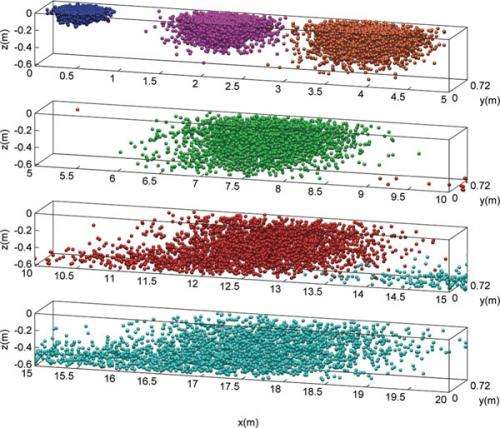Model developed to track eggs of Asian carp, an invasive species

(Phys.org) —Asian carp are knocking on the door of the Great Lakes, but managers now can better pinpoint strategies to control their rapidly increasing population, according to a new model for tracking carp eggs developed by researchers at the University of Illinois and the United States Geological Survey.
Asian carp, a collective term for several invasive carp species, have become a scourge of the Mississippi River basin and have steadily spread toward the Great Lakes. The fish aggressively compete for food with native species, and one carp can lay millions of eggs each year. With such exponential population growth, Asian carp could become a dominant species in the Great Lakes system, which could have a large economic impact on the shipping and fishing industries in the region. Many measures have been explored to control the spread of Asian carp in North American waters.
"Knowing how the eggs are being transported may also help decision-makers develop control mechanisms," said Tatiana Garcia, a U. of I. graduate student and the first author of the paper detailing the new control model. "For example, if Asian carp spawn in a certain location, where are they going to hatch? Resource managers could use this model to identify which tributaries of the Great Lakes will be suitable for spawning. The model also can help determine where Asian carp are going to hatch based on where they spawn. What is the minimum distance eggs need to remain in suspension to hatch? Where can we find juveniles? Can we put up barriers especially for eggs?"
The model, called Fluvial Egg Drift Simulator (FluEgg), follows a clutch of eggs over time as they travel downstream. Since carp spawn in turbulent waters, they seek places such as dams and spillways. To establish a large population in the Great Lakes, the carp would have to leave the lakes to spawn in the tributaries where the water moves rapidly, usually downstream from dams and spillways, where there is a lot of turbulence. The eggs have to stay suspended in the current to hatch – if they settle on the bottom, they die.
"The challenge is, of all those million of eggs, how many of those end up hatching?" said Marcelo Garcia, the U. of I. professor of civil and environmental engineering who led the project. "Our challenge has been to find a way to simulate this process from the spawning point all the way downstream. If the eggs are not kept in suspension, they will not be viable and they will die out. We have a model to look at certain streams – like tributaries to the Great Lakes – and figure out whether those streams are potential areas for Asian carp to reproduce. I think we have put together a tool that is going to be eye-opening, to say the least. It's going to be a lot easier to visualize the transport and the conditions you need for hatching."
Published in the journal Ecological Modeling, FluEgg is the first model to take into account the detailed hydrodynamics of a river or stream – such as temperature, flow velocity and turbulence – as well as biologic data as eggs develop and change in size and density.
"FluEgg follows every virtual egg based on the velocity and turbulence of the river you are simulating," Tatiana Garcia said. "The location of the eggs is tracked in time in a three dimensional space. The model helps answer the question of, if carp have spawned at a certain location, how will the eggs be dispersed downstream? Will they sink? Will they hatch before reaching the Great Lakes? The answers to these questions are critical components in research to determine if the Asian carp can establish a sustainable population in the Great Lakes."
See a video of FluEgg in action:
The researchers used FluEgg to evaluate the Sandusky River in Ohio, a tributary to Lake Erie. USGS researchers collected detailed hydrodynamic and water-quality data on site. The Illinois researchers used that data and found that the Sandusky River could indeed act as a breeding ground for Asian carp in Lake Erie during the warmest summer months – a surprise, since it had been previously thought that the river was too short to support egg hatching.
"We've shown that at the right temperature, the Sandusky River can support spawning and egg development to hatching," said Elizabeth Murphy, a USGS hydrologist. "These findings show that Asian carp may be able to spawn in more Great Lakes tributaries than previously estimated. This information could help resource managers implement control measures and potentially prevent Asian carp from becoming established in the Great Lakes."
Next, the researchers plan to use FluEgg to evaluate more tributaries, and to perform experiments with artificial eggs to continue to fine-tune the FluEgg model.
"I'm excited that we have developed this tool that we are giving to managers," Tatiana Garcia said. "Now they can make more informed decisions based on data and the actual conditions of a river. In this way we can optimize our resources. I'm excited to see what the decision-makers can do with this tool. "
Provided by University of Illinois at Urbana-Champaign

















